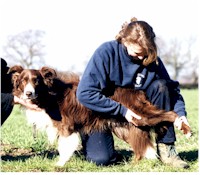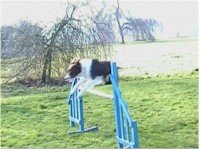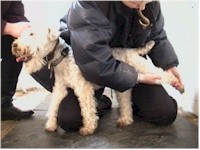Put the joy
back into
jumping...
 Most
dogs naturally enjoy agility, and when they feel restricted or unwell, they may not perform at
their best. Prompt of assessment of an injury following a tumble can save a great deal of
pain for both the dog and its owner, and regular check-ups for recent or longstanding problems
can avoid lameness, arthritis and back problems. Animal osteopath Julie Vaughan explains what
you can do when rest and painkillers are not enough. Most
dogs naturally enjoy agility, and when they feel restricted or unwell, they may not perform at
their best. Prompt of assessment of an injury following a tumble can save a great deal of
pain for both the dog and its owner, and regular check-ups for recent or longstanding problems
can avoid lameness, arthritis and back problems. Animal osteopath Julie Vaughan explains what
you can do when rest and painkillers are not enough.
It is necessary to stress the importance of early
detection of injury and prompt assessment following its onset. Very often a dog is brought to
me who has had an initial injury or onset of a problem which has then got better for a while.
The owner, not surprisingly, assumes that the dog has got better. All too often though, it is
the body's ability to compensate for an injury that brings about an apparent recovery. Over
time, the body begins to fatigue under the extra workload of compensating and the problems then
return, sometimes with added complications. Osteopathy can make a difference.
What is Osteopathy?
Osteopathy is a system of evaluation and treatment of the
musculo-skeletal system (the bones, joints, muscles, ligaments and connective tissue). It
combines scientific knowledge of anatomy and physiology and clinical methods of investigation.
Osteopaths diagnose and treat
faults that occur because of injury, stress or perhaps disease, to enable the musculo-skeletal
system to work as efficiently as possible, allowing the body to restore itself to normal
function.
Osteopaths use a highly developed sense
of touch (palpation) in order to locate altered function of the muscle-skeletal system. This
sense of touch is especially important in the treatment of animals, as they cannot tell us
where their pain is.
Following treatment, an Osteopath may
also advise on how optimum function and health may be maintained and injury prevented in the
future. This may include advice on handling, exercise and training to maintain mobility or in
the case of horses, advice on riding, schooling technique and use of comfortable tack.
Why is Osteopathy
treatment important for animals?
Unlike us, animals cannot communicate their pain
very easily. Pain and discomfort in animals can be manifested as altered temperament. In dogs
symptoms can include: a general reluctance to get out of their cage or the car,
unprovoked aggression, evading obstacles, inability to co-ordinate, rushing at jumps, ignoring
commands and difficulty in stretching out hind legs when jumping (right). In all animals
there can be an unwillingness to co-operate; depression and apathy; fear or aggression.
Many of these behaviours are
symptoms of pain and discomfort. They can easily be misinterpreted as ‘naughtiness’ or
‘napping’. Animals are usually willing and enjoy co-operating with their handlers. When we ask
them to perform tasks whilst they are in pain, they can easily learn to mistrust and fear us.
Other manifestations of musculo-skeletal problems include
not being able to carry out tasks. Dogs may have difficulty jumping, becoming awkward or
refusing.
Often, a handler's approach to the
difficulties described is to become increasingly forceful in order to make the animal
co-operate. This may be effective in the short term. Unfortunately, the animals’
musculo-skeletal system may not continue to compensate for the problem. This is when further
damage may occur.
It is important to take action when
your animal displays signs of discomfort and pain. What may begin as stiffness and
unwillingness, if ignored, may develop into serious injury and fear.
 Treatment Treatment
Instead of using drugs Osteopaths carry out treatment using a variety
of manipulative techniques. These may include soft tissue stretching, rhythmic passive joint
movements or high velocity thrust techniques to improve the range of movement of a joint.
Much long- term, chronic pain is
caused by degenerative changes that have taken place. However, Osteopathic treatment using
gentle, manual techniques may often ease pain, reduce swelling and improve joint mobility.
Treatment is not painful and
animals usually find it relaxing.
Behavioural work may need to be
undertaken when a painful problem has led to the animal
 displaying
symptoms of fear and aggression when handled. This is all part of the individual healthcare
programme. displaying
symptoms of fear and aggression when handled. This is all part of the individual healthcare
programme.
The consultation
A full case history is taken, detailing the animal’s condition and onset of the problem
including any relevant medical history.
The animal is then
observed in various phases of movement. This may involve lunging or free schooling a horse or
seeing it ridden. The horse is also observed at trot and walk, backing up and turning short. A
dog may be let off the lead for observation, trotted up or, in the case of a trained dog, seen
performing obedience/agility tests etc. The animal is then examined at rest. The Osteopath uses
palpation (examination using sense of touch) to locate areas of stiffness and poor function.
Any areas of injury, excessive strain
or weakness will be identified. The case history and examination allow the Osteopath to
formulate a diagnosis and treatment plan. Treatment usually begins on the first visit.
Training &
regulation
Training in animal Osteopathy is done at post-graduate level.
It involves study of anatomy, conformation, pathology, bio- mechanics, behaviour and
psychology, schooling techniques and shoeing. Intensive practical training is undertaken at
racing yards, greyhound yards and veterinary surgeries.
What do
Osteopaths treat?
Animals suffer injuries to the neck, back, pelvis and other
joints due to three main factors:
- Injury
- Overuse
- Wear and tear
When damage has occurred to a joint,
the joint complex becomes stiff and functions poorly. The health of the surrounding tissues
deteriorates and is prone to further trauma. The damage may be immediately obvious, but often
the changes are so subtle as to go undetected.
Over time, the damage increases. The
body attempts to compensate and related joints and muscles may suffer overuse. The effort
required to achieve normal function increases greatly. Tissues fatigue easily and are prone to
further injury. Degeneration of the joint complex may be accelerated.
An example of this process is when a
dog has suffered a fall or similar trauma and continues to work with little or no symptoms.
Sometime later however, the dog may under achieve, move better on one leg than the other or
display lameness with no demonstrable cause in the limb. There may still be no physical sign of
problems but because of increasing discomfort the dog may alter in temperament, play up or
refuse to work.
Osteopathy aids the body’s own healing
mechanism to restore normal function and alleviate pain. When there is joint degeneration,
function can still be improved and maintained, improving quality of life.
 About
the author... About
the author...
Julie. C. Vaughan BSc(OST) Registered Osteopath always had a love of animals from a
very early age. Her grandparents had a dog and as well as being dragged round the block by him
for walks, she used to offer her services as dog walker, groom and playmate to a number of the
neighbours' dogs. Unfortunately growing up with both parents in full time work meant they
couldn't own one, and living in inner city Leeds with limited finances, a horse was also out of
the question. She did find ways of being with horses though, even if it meant at the age of
nine regularly cycling five miles to a show jumping yard to spend hours watching the grooms and
occasionally being allowed to brush a horse for her determination!
About this time she wanted to be a vet. However, she knew
that she would not enjoy the surgery and would find the accident cases very upsetting. Still
interested in medicine, she began to find out what other options there were. Her uncle was an
Osteopath, and she was fascinated by the ability of someone to alleviate pain and encourage the
body to repair and return to normal function without the use of drugs.
After A-Levels she attended the British School of
Osteopathy in Central London. It was a four year full time course and she graduated in 1994
with a degree in Osteopathy. Animal Osteopathy is not taught at undergraduate level, but she
knew that once established as an Osteopath for people, she could then apply her skills to
animals.
This became possible when she moved to Leicester.
She had been working in two large practices in Leeds and Wakefield but moved to Leicestershire
to develop her career. She studied Animal Osteopathy over the next three years whilst still
working in two human practices. She worked with greyhounds and race horses whilst training, and
developed a mainly equine practice, travelling around Leicestershire and surrounding counties
to treat horses as she did not have a premises to work from.
Not having a base hindered her development of the canine
practice. Fortunately the Osteopath who owns the practice where she works on people tolerated
her enthusiasm well and allowed her to treat dogs in a spare room! However, as fate would have
it, a colleague had farm buildings that were in need of a use!! She has not looked back since
and with the support of her colleague and her family have been able to establish an animal
practice at the farm.
Julie's interest in agility began in that same spare room
when agility handlers started to come to her with all kinds of unresolved injuries - sometimes
of their own as well as their dog's! She learned that these dogs particularly required optimum
physical ability in order to work well. They are also prone to injury - as is any athlete -
and it is of utmost importance that those injuries resolve fully and the body is restored to
normal function. Just the requirements that Osteopathy can so often meet when rest and drugs
are not enough!!
Julie has worked on some high profile dogs with high
profile owners!! The results she has achieved have encourages her to become more involved with
agility dogs. Thoroughly enjoying the work, she is expanding the animal practice, much to the
consternation of her human patients!. A new building is going up at this very moment which will
make the environment where she treats the dogs in much more comfortable. This really is for the
owners' benefit rather than the dogs! The dogs seem to enjoy their trips to the farm, lots of
interesting smells and not at all clinical!
Julie says that she would love to own her own dogs and
horses in the future, but unfortunately studying and work commitments do not leave her much
time at the moment. She'll have to get her 'animal fix' by working with them!
For appointments
and further information about Osteopathy for dogs,
contact Julie Vaughan at Animal Life Healthcare, Leicester area
Tel. 0788-7547137.
From Jane Dove
Could you include information on the health of dogs when competing in Agility, especially
Osteopaths?
One of my dogs, a manic Collie, is now
four years old. She loves Agility and is in a desperate rush to do the next obstacle. She
particularly enjoys the weaves, but I've had numerous problems with her, not only because of
her speed, but because of the fact she has little respect for obstacles. Last year, when
travelling at the speed of light into the weaves, she slipped and almost dislocated her
shoulder. The year before she hit the weaves again which almost resulted in a slipped disc.
To date, I have taken her to an
Osteopath four times where she has her entire backbone manipulated. Her pelvis is always out of
line which, I am told, is common in most agility dogs. She's had the vertebrae in her
back put back into place and her shoulder is manipulated. We discovered a specific problem when
I mentioned that the dog continually avoided the bend from the first to second weave. The
Osteopath was able to identify from her injuries that she would have found it difficult and
painful to turn sharp left which is exactly what a correct weave entry is.
I can recommend a yearly check for all
agility dogs in this way, with further visits if there seems to be a specific problem. If the
osteopath is good, then he/she should recommend that you should not bring the dog back for more
treatment than is necessary. The treatment is not expensive. I think I paid around £12 for one
appointment.
|